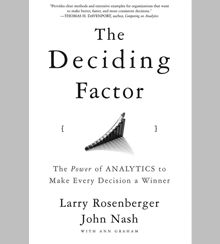Akbank Goes Mobile
Edward Landry, coauthor of The Four Pillars of Profit-Driven Marketing: How to Maximize Creativity, Accountability, and ROI, introduces a passage on how analytics create competitive advantage from The Deciding Factor: The Power of Analytics to Make Every Decision a Winner, by Larry Rosenberger and John Nash, with Ann Graham.
As the value of corporate assets such as ubiquitous brands, an expansive footprint of outlets, and large cash reserves has diminished, the importance of organizational capabilities has grown. In today’s competitive markets, smaller and nimbler companies that understand the interplay between assets and capabilities can outperform much larger competitors that don’t. It is this combination of assets and capabilities that creates a “right to win.”
In the passage you are about to read, Larry Rosenberger and John Nash of the Fair Isaac Corporation (FICO) show how an established Turkish bank used a powerful combination of assets and capabilities both to find a new way to interact with consumers where they live, work, and play, and to make faster, better business decisions. Notice how the bank combined analytics, decision support tools, process, and organization to build a mobile marketing channel. These are the four key building blocks required to develop any industry-leading marketing capability. You can create value by utilizing one or two of these elements, but sustainable advantage — the type of advantage that enables companies to surpass more powerful global competitors — comes from developing and integrating all four.
— Edward Landry
Excerpted from Chapter 7 of The Deciding Factor: The Power of Analytics to Make Every Decision a Winner
Akbank T.A.S. is the largest of four retail banks in Turkey vying for consumer lending and credit card services aimed at middle-income customers, many of whom are using banking services for the first time. Turkey has a total population of approximately 72 million, and as is typical of emerging economies, there is a large income disparity between the ultra-affluent and the rest of the population. Retail banks such as Akbank have historically served a small, high-net-worth customer base, but in Turkey these days, growth depends on winning over the middle-income consumer and consumers who are using banking services for the first time.
Akbank has been able to build several layers of IT infrastructure from scratch. Because of this, it isn’t burdened with the product-centric legacy of IT systems of banks in the United States and Western Europe. Robert Duque-Ruberio, a Fair Isaac vice-president based in London who has worked with Akbank since 2000, confirms this: “I watched the banking industry in Turkey do in four years what it took twenty years to do in the U.K. These countries are going to leapfrog developed markets. What’s exciting is that they see new things and are willing to try them.”
Akbank operates Turkey’s second largest consumer banking branch network. In the summer of 2003, Akbank managers approached Fair Isaac with an idea of creating an online channel to lower the bank’s cost of acquiring new customers and to increase convenience for its customers. Cell phone usage in Turkey has been rising steadily for years, and home-based Internet access is now more common. Akbank’s managers decided that making a cell phone a channel to apply for a loan would stimulate even higher volumes of applications than the Internet. Applications are carefully screened using credit risk scores. The strategy was to use technology to offer consumers speed and convenience while simultaneously managing customer profitability and losses among segments with different risk profiles.
In December 2005, the mobile phone–based loan origination program, called CepKredi (which in Turkish means “speedy cell credit”), was launched. A customer can be anywhere when he or she decides to dial in for a loan — at home watching television, walking down the street, or riding a train. The CepKredi phone number, 44400011, is heavily advertised on television, in print media, and on billboards.
When the consumer calls to apply for a credit card or a loan, an interactive voice response system asks eleven questions. Completing the application takes less than five minutes, an instant credit scoring analysis is done, and within twenty minutes the consumer receives a voicemail or an SMS text message on their cell phone stating whether the application has been accepted or rejected.
The result? In 2006, approximately fifty-three thousand people received loans through Akbank’s mobile phone credit service.
Moreover, here’s even more impressive growth:
- Since 2005, Akbank’s retail customer base has grown to more than 5.4 million retail customers.
- In 2007, the annual report noted that 2.35 million customers per month now use Akbank’s mobile channel, and 61 percent of the bank’s transactions are carried out through these channels.
- Akbank has seven hundred thousand Internet branch customers.
- Customers carry out 32 percent of the bank’s transactions on the Internet.
- Akbank has about 1,615 ATMs — 10 percent of all ATMs in the country.
- Approximately 1.9 million people a month use Akbank ATMs.
Akbank is demonstrating the leapfrog advantage of established emerging market retail banks. By investing early and strategically, Akbank now has a head start over local and international competitors. And by integrating decision management technology into its IT infrastructure, it has the databases to capture all the internal and external data on a given customer. (In Turkey, the government-supported credit bureau was established in 2002.) Akbank’s credit management system, which includes behavior scoring and adaptive control technology, covers the entire credit life cycle, including prospecting for customers, underwriting loans, and managing customer accounts. The system runs through 17 different paths, 620 rules, 390 strategies, 330 scenarios, and 5,327 steps.
Decision management is also critical to Akbank’s strategy of aggressive but controlled market share growth, as it expands into new middle-income and “unbanked” segments. Akbank will need to be agile and vigilant in controlling delinquency and fraud. Akbank’s creative use of electronic channels has put it in a strong position to realize these additional goals:
- To take advantage of data on prospective customers and current customers for cross-selling products
- To increase the efficiency and effectiveness of marketing initiatives
- To increase profit per customer
In 2006, CitiGroup bought a 20 percent stake in Akbank for $3.1 billion. CitiGroup’s global brand and technology is now combined powerfully with Akbank’s knowledge of the market. The collaboration is specifically about growing the retail bank, joint investments in technology, and managerial sharing. Finally, although Akbank currently serves only the Turkish market, expansion into Europe is on its radar.
— Larry Rosenberger and John Nash, with Ann Graham
Reprinted by permission of the publisher, Jossey-Bass, an imprint of John Wiley & Sons Inc., from The Deciding Factor: The Power of Analytics to Make Every Decision a Winner by Larry Rosenberger and John Nash, with Ann Graham. Copyright (c) 2009 by Larry Rosenberger and John Nash. All rights reserved.




